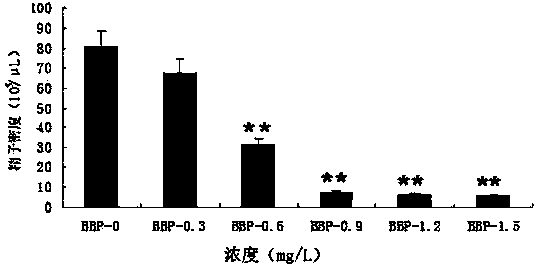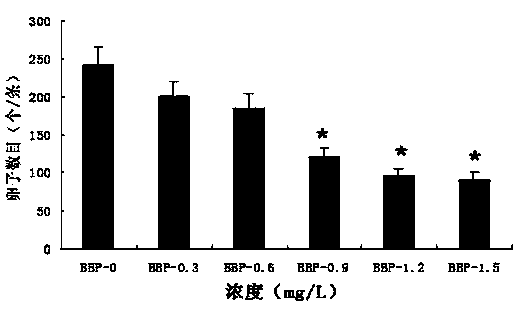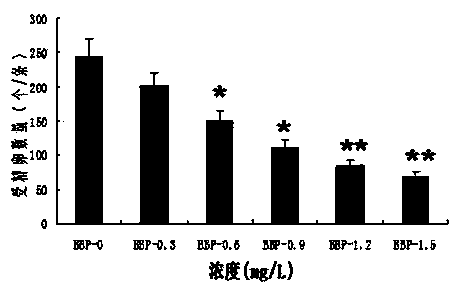Application of zebra fish in detection of reproduction toxicity of BBP (Butyl Benzyl Phthalate) and method for rapidly detecting reproduction toxicity of BBP
A reproductive toxicity, zebrafish technology, applied in measurement devices, instruments, scientific instruments, etc., can solve the problems of high sample purity, poor sensitivity, and uncertain detection indicators.
- Summary
- Abstract
- Description
- Claims
- Application Information
AI Technical Summary
Problems solved by technology
Method used
Image
Examples
Embodiment 1
[0026] 1. Breeding of zebrafish: 1) Wild-type zebrafish of the AB line were purchased from the International Zebrafish Center of Oregon State University (Oregon State University, OR. USA). Adult zebrafish were housed in 2.5 L aquariums with circulating system water passing through them. Adult zebrafish were fed brine shrimp twice a day. The brine shrimp are hatched from synthetic seawater. From 2 to 16 days after birth, the juvenile fish were fed with artificial feed Hatchfry EncapsulonTM (Argent Chemical Laboratories, Redmond, WA, USA). The constant temperature of the fish room is 28.5 oC, and the time of lighting and turning off the lights is 14:10 hours; 2) The tap water is filtered by activated carbon and treated by a reverse osmosis device to obtain purified water, and then natural salt of analytical purity is added to it to synthesize water that meets the requirements of the US Environmental Protection Agency. Standard (U.S. Environmental Protection Agency Guideline, U...
Embodiment 2
[0034] In order to further understand the effects of BBP exposure on the reproductive function of female and male fish, we designed a permutation mating experiment with control female / male fish respectively.
[0035] a, raising of zebrafish: with embodiment 1.
[0036] b. Detecting the acute toxic effect of BBP on zebrafish for 7 days: the same as in Example 1.
[0037] c. The reproductive toxicity of BBP was detected in the female / male fish replacement mating experiment: BBP treatment group (BBP concentrations were 0.6 mg.L -1 ,0.9 mg.L -1 ,1.2 mg.L -1 ,1.5mg.L -1 ) each randomly selected 18 males and each randomly selected 18 females. Eighteen males from each BBP treatment group were removed and replaced with 18 males from the solvent control group (BBP concentration 0), and mated with the corresponding females of the BBP treatment group. The same substitution was also applied to the females of each BBP treatment group. At 8 o'clock the next day, collect fish roe stati...
PUM
 Login to View More
Login to View More Abstract
Description
Claims
Application Information
 Login to View More
Login to View More - R&D
- Intellectual Property
- Life Sciences
- Materials
- Tech Scout
- Unparalleled Data Quality
- Higher Quality Content
- 60% Fewer Hallucinations
Browse by: Latest US Patents, China's latest patents, Technical Efficacy Thesaurus, Application Domain, Technology Topic, Popular Technical Reports.
© 2025 PatSnap. All rights reserved.Legal|Privacy policy|Modern Slavery Act Transparency Statement|Sitemap|About US| Contact US: help@patsnap.com



